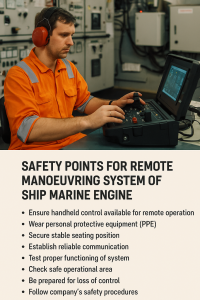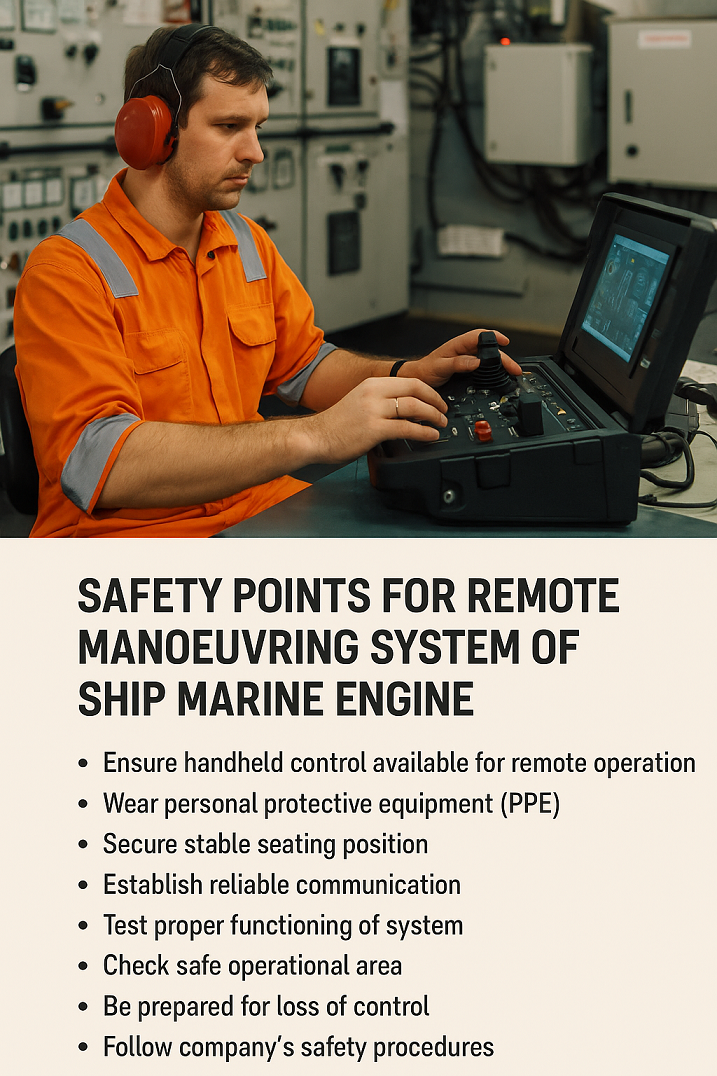Discover the top 12 safety points for remote manoeuvring systems in marine engines. Learn essential precautions, real-world incidents, and international standards to enhance shipboard engine control safety.
Remote manoeuvring systems have transformed how marine engines are operated. Gone are the days when bridge-to-engine-room communication relied solely on telegraphs and human interpretation. Today’s modern vessels are equipped with integrated remote control systems that allow engine orders—start, stop, ahead, astern—to be executed with precision from the bridge. But while convenience has increased, so has the complexity—and with it, the need for strict safety measures.
In this guide, we’ll explore 12 key safety precautions that marine engineers and navigators must follow when working with a ship’s remote manoeuvring system. Whether you’re preparing for your Officer of the Watch (OOW) exam or leading an engine room team, this article is designed to offer technical clarity and real-world context.

Why Remote Manoeuvring Systems Matter in Modern Maritime Operations
The shift to remote-controlled main engines, especially with electronically controlled two-stroke engines like MAN B&W ME-C or Wärtsilä RT-flex, has enhanced bridge autonomy and improved ship handling during maneuvers. These systems are central to safe navigation in congested waters, rapid emergency response, and compliance with unmanned machinery space (UMS) requirements.
But a failure or miscommunication in the remote manoeuvring system can lead to serious consequences, such as:
- Delayed response during docking
- Engine failure in narrow channels
- Uncommanded engine movements
In 2021, a chemical tanker in the Baltic Sea experienced a loss of propulsion due to a failed control signal relay. The ship was towed to port, and investigations highlighted improper testing of the remote system as a root cause (MAIB Report No. 12/2022).
Know the Control Modes and Authority Hierarchy
A ship’s engine remote system usually has several control modes:
- Bridge control
- Engine Control Room (ECR) control
- Local emergency control (manual push buttons on the engine)
Safety depends on understanding which mode is active. Before sailing, confirm with the bridge team:
- Control transfer protocols
- Manual override capability
- Alarm and interlock testing procedures
According to DNV and ClassNK guidelines, the control transfer system must have clear visual indicators and audible alarms when transitioning between modes.
Verify System Alarms and Monitoring Signals
Remote manoeuvring relies on electronic feedback. Position sensors, command relays, and control air signals must all be functional.
Before departure:
- Check alarms for signal failure, command mismatch, or low control air pressure
- Verify the status of shaft revolution feedback and starting air system
Wärtsilä recommends conducting a “dry test” of commands before departure, confirming response without actually starting the engine.
Monitor Starting Air System Pressure and Valves
No remote control system will function properly without a healthy starting air system. Check:
- Starting air receiver pressure (typically above 27 bar)
- Main and auxiliary starting valves
- Automatic drain valves to prevent water ingress
In 2020, a vessel detained by Paris MoU had unserviceable auto-drain valves that led to water entering the control air lines—disabling remote engine start.
Inspect Telegraph Signal Transmission Path
The bridge telegraph (often digital, sometimes hybrid electro-pneumatic) must have:
- Secure connections
- Confirmed feedback loop from the engine to the bridge
- Alarm activation for mismatched or failed signals
The IMO and IACS UR E10 require redundancy in remote control signal lines—especially for vessels operating in Special Areas or under DP (dynamic positioning) modes.
Confirm Emergency Stop and Shutdown Logic
All remote manoeuvring systems must include:
- Emergency stop from bridge and ECR
- Shutdown logic interlocked with crankcase pressure, over-speed, and lubricating oil pressure
It’s not enough to assume the emergency stop works. Test it under supervision as part of weekly safety rounds and document the outcome.
According to SOLAS Chapter II-1, Part C, Regulation 31.2, the propulsion system must be capable of emergency shutdown from a remote location without disabling steering or essential auxiliaries.
Maintain Redundant Power Supplies and Control Units
Remote control panels must be supplied from:
- Main switchboard
- Emergency switchboard
In case of blackouts, a UPS (uninterrupted power supply) ensures continuity. Class societies like ABS and RINA mandate that control system CPUs have battery backup or alternate circuits.
Regularly test:
- Battery condition
- Transfer logic between power sources
If a voltage drop causes CPU reboot mid-manoeuvre, you could lose engine control at the worst moment.
Validate Interlocks for Reversing, Starting, and Fuel Admission
Remote engine controls are governed by numerous interlocks:
- Start interlock (engine must be stopped before restart)
- Reversing interlock (prevents air start until the direction is confirmed)
- Fuel shut-off in case of overspeed or fault
Don’t bypass these during drills or tests unless under Chief Engineer supervision. A ClassNK surveyor once found a vessel where interlocks had been overridden for simulator purposes—and never reset. The ship failed its annual survey.
Coordinate Manoeuvring Drills with Bridge and Deck Teams
Safety is a team exercise. Before maneuvering:
- Hold a pre-departure or pre-arrival briefing
- Confirm main engine RPM ranges with the master
- Align thruster use with engine ahead/astern sequences
Bridge Control Transfer Test (BCTT) must be part of every UMS-certified vessel’s checklist, as per ISM Code Clause 7.
Monitor Engine Room Environmental Conditions
Heat, humidity, and vibration affect electronic control systems. Maintain engine room environment within:
- 10–45°C (as per IMO guidelines)
- Less than 85% relative humidity
Clean ventilation ensures PLCs, relays, and contactors don’t fail from salt or soot ingress. Alfa Laval’s 2022 white paper warns of increased controller failures in tropical voyages due to poor HVAC upkeep.
Test Fail-Safe Operation of Local Control
In the event of remote failure, manual control must take over. Local control panel near the main engine must:
- Bypass bridge and ECR control
- Use direct solenoids or hand-operated valves
Practice switching from remote to local every month. MAIB’s 2023 analysis found that many engineers had never tested local start procedures—causing confusion during critical incidents.
Keep System Schematics and Manuals Ready
Remote manoeuvring systems are often custom-built. Keep:
- OEM diagrams near the ECR and bridge
- Fault isolation guides laminated
- Alarm codes documented and explained to junior engineers
During Port State Control, inspectors frequently ask engineers to identify and explain alarm causes. Having materials ready can prevent a detention.
Real-World Case Study: Bulk Carrier Near-Miss in Singapore Strait
In 2022, a 65,000 DWT bulk carrier faced engine failure just after pilot boarding. The master had issued a “dead slow ahead” order, but the engine did not respond. Investigation revealed:
- The remote system’s CPU rebooted due to low voltage
- Engineers had no immediate access to local control
- Emergency stop had been inadvertently activated during a test
The ship narrowly avoided grounding, thanks to anchor deployment and tug assistance. After the incident, the operator revised its remote manoeuvring SOPs and introduced regular crew drills.
FAQ: Remote Manoeuvring System Safety
What is a remote manoeuvring system in marine engines?
It allows control of the main engine (start/stop, ahead/astern, RPM) from the ship’s bridge, eliminating the need for manual input in the engine room during navigation.
Is it safe to rely on remote controls for critical engine operations?
Yes, if backed by proper testing, redundancy, and manual override capability. Classification societies mandate rigorous testing.
Can you operate the engine locally if the remote system fails?
Yes, local control is always available as a backup. It is essential to regularly test this mode.
What should be checked before using the remote system?
Power supply, signal integrity, starting air readiness, alarm functionality, and interlocks.
What regulations govern remote engine control systems?
SOLAS II-1, ISM Code, IACS UR E10, and class society rules (e.g., DNV, ABS, LR) outline safety and functional requirements.
Conclusion: Safety is Not Optional—It’s Integral
Remote manoeuvring systems offer speed, precision, and autonomy—but only when treated with the respect and diligence they deserve. The convenience of pushing a button from the bridge masks a complex network of valves, sensors, and logic circuits. Any lapse in testing, coordination, or maintenance can turn that convenience into catastrophe.
The good news? Every engineer and officer can make a difference. By embedding these 12 safety practices into your daily routine, you not only meet regulatory requirements—you build a culture of awareness, professionalism, and safety that protects your ship and crew.
References
- International Maritime Organization. (2023). SOLAS Consolidated Edition. https://www.imo.org
- Marine Accident Investigation Branch. (2022). Investigation Reports. https://www.gov.uk/maib
- ClassNK. (2023). Remote Control Systems Guidelines. https://www.classnk.or.jp
- Wärtsilä. (2022). RT-flex Engine Control System Manual.
- MAN Energy Solutions. (2023). ME-C Engine Operating Instructions.
- ABS. (2022). Automation System Requirements. https://ww2.eagle.org
- DNV. (2022). Rules for Classification: Part 4 – Machinery and Systems. https://www.dnv.com
- Alfa Laval. (2022). Control Systems and Engine Room Climate. https://www.alfalaval.com
- Inmarsat. (2023). Shipboard Control System Resilience Reports. https://www.inmarsat.com
- BIMCO. (2023). Marine Engineering Safety Briefings. https://www.bimco.org

